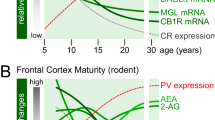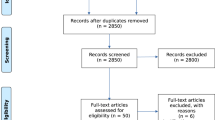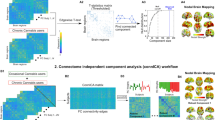Abstract
Animal and cellular work has shown that central cannabinoid-1 receptors modulate neural oscillations in the gamma range (40 Hz), which may be important for normal perceptual and cognitive processes. In order to assess the effect of cannabinoids on broadband-frequency neural oscillations in humans, the current study examined the effect of chronic cannabis use on auditory steady-state responses (ASSRs) utilizing electroencephalography (EEG). Passive ASSRs were assessed using varying rates of binaural stimulation (auditory click-trains; 10–50 Hz in increments of 5 Hz; 80 dB SPL) in carefully screened cannabis users and controls. Chronic cannabis users (n=22; 12 h abstinence before study; positive 11-nor-9-carboxy-delta-9-tetrahydrocannabinol urine levels) and cannabis naïve controls (n=24) were evaluated. Time X frequency analyses on EEG data were performed using Fourier-based mean trial power (MTP) and phase-locking (inter-trial coherence; ITC). Transient ERPs to stimulus onset (auditory N100 components) were also evaluated. As predicted, a decrease in spectral power (MTP) at 40 Hz was observed in the cannabis group (p<0.018). No effects on phase-locking (ITC) or the N100 were observed. Further, within the cannabis group, lower 40 Hz power correlated with an earlier age of onset of cannabis use (p<0.04). These data suggest that chronic exposure to exogenous cannabinoids can alter the ability to generate neural oscillations, particularly in the gamma range. This is consistent with preclinical animal and cellular data, which may have implications for understanding the short- and long-term psychopharmacological effects of cannabis.
Similar content being viewed by others
Log in or create a free account to read this content
Gain free access to this article, as well as selected content from this journal and more on nature.com
or
References
Ali AB, Todorova M (2010). Asynchronous release of GABA via tonic cannabinoid receptor activation at identified interneuron synapses in rat CA1. Eur J Neurosci 31: 1196–1207.
Bacci A, Huguenard JR, Prince DA (2004). Long-lasting self-inhibition of neocortical interneurons mediated by endocannabinoids. Nature 431: 312–316.
Bocker KB, Hunault CC, Gerritsen J, Kruidenier M, Mensinga TT, Kenemans JL (2010). Cannabinoid modulations of resting state EEG theta power and working memory are correlated in humans. J Cogn Neurosci 22: 1906–1916.
Bodor AL, Katona I, Nyiri G, Mackie K, Ledent C, Hajos N et al (2005). Endocannabinoid signaling in rat somatosensory cortex: laminar differences and involvement of specific interneuron types. J Neurosci 25: 6845–6856.
Delorme A, Makeig S (2004). EEGLAB: an open source toolbox for analysis of single-trial EEG dynamics including independent component analysis. J Neurosci Methods 134: 9–21.
Devane WA, Dysarz 3rd FA, Johnson MR, Melvin LS, Howlett AC (1988). Determination and characterization of a cannabinoid receptor in rat brain. Mol Pharmacol 34: 605–613.
Edwards CR, Skosnik PD, Steinmetz AB, O’Donnell BF, Hetrick WP (2009). Sensory gating impairments in heavy cannabis users are associated with altered neural oscillations. Behav Neurosci 123: 894–904.
Edwards CR, Skosnik PD, Steinmetz AB, Vollmer JM, O’Donnell BF, Hetrick WP (2008). Assessment of forebrain-dependent trace eyeblink conditioning in chronic cannabis users. Neurosci Lett 439: 264–268.
Egertova M, Elphick MR (2000). Localisation of cannabinoid receptors in the rat brain using antibodies to the intracellular C-terminal tail of CB. J Comp Neurol 422: 159–171.
Eggan SM, Lewis DA (2007). Immunocytochemical distribution of the cannabinoid CB1 receptor in the primate neocortex: a regional and laminar analysis. Cereb Cortex 17: 175–191.
Eggan SM, Melchitzky DS, Sesack SR, Fish KN, Lewis DA (2010). Relationship of cannabinoid CB1 receptor and cholecystokinin immunoreactivity in monkey dorsolateral prefrontal cortex. Neuroscience 169: 1651–1661.
Farkas I, Kallo I, Deli L, Vida B, Hrabovszky E, Fekete C et al (2010). Retrograde endocannabinoid signaling reduces GABAergic synaptic transmission to gonadotropin-releasing hormone neurons. Endocrinology 151: 5818–5829.
Foldy C, Neu A, Jones MV, Soltesz I (2006). Presynaptic, activity-dependent modulation of cannabinoid type 1 receptor-mediated inhibition of GABA release. J Neurosci 26: 1465–1469.
Freund TF, Katona I, Piomelli D (2003). Role of endogenous cannabinoids in synaptic signaling. Physiol Rev 83: 1017–1066.
Fridberg DJ, Vollmer JM, O’Donnell BF, Skosnik PD (2010). Cannabis users differ from non-users on measures of personality and schizotypy. Psychiatry Res 186: 46–52.
Galambos R, Makeig S, Talmachoff PJ (1981). A 40-Hz auditory potential recorded from the human scalp. Proc Natl Acad Sci USA 78: 2643–2647.
Gaoni Y, Mechoulam R (1971). The isolation and structure of delta-1-tetrahydrocannabinol and other neutral cannabinoids from hashish. J Am Chem Soc 93: 217–224.
Glass M, Dragunow M, Faull RL (1997). Cannabinoid receptors in the human brain: a detailed anatomical and quantitative autoradiographic study in the fetal, neonatal and adult human brain. Neuroscience 77: 299–318.
Gratton G, Coles MG, Donchin E (1983). A new method for off-line removal of ocular artifact. Electroencephalogr Clin Neurophysiol 55: 468–484.
Hajos M, Hoffmann WE, Kocsis B (2008). Activation of cannabinoid-1 receptors disrupts sensory gating and neuronal oscillation: relevance to schizophrenia. Biol Psychiatry 63: 1075–1083.
Hajos N, Katona I, Naiem SS, MacKie K, Ledent C, Mody I et al (2000). Cannabinoids inhibit hippocampal GABAergic transmission and network oscillations. Eur J Neurosci 12: 3239–3249.
Hari R, Hamalainen M, Joutsiniemi SL (1989a). Neuromagnetic steady-state responses to auditory stimuli. J Acoust Soc Am 86: 1033–1039.
Hari R, Joutsiniemi SL, Hamalainen M, Vilkman V (1989b). Neuromagnetic responses of human auditory cortex to interruptions in a steady rhythm. Neurosci Lett 99: 164–168.
Harkany T, Guzman M, Galve-Roperh I, Berghuis P, Devi LA, Mackie K (2007). The emerging functions of endocannabinoid signaling during CNS development. Trends Pharmacol Sci 28: 83–92.
Harkany T, Keimpema E, Barabas K, Mulder J (2008a). Endocannabinoid functions controlling neuronal specification during brain development. Mol Cell Endocrinol 286 (1–2 Suppl 1): S84–S90.
Harkany T, Mackie K, Doherty P (2008b). Wiring and firing neuronal networks: endocannabinoids take center stage. Curr Opin Neurobiol 18: 338–345.
Herkenham M, Lynn AB, Little MD, Johnson MR, Melvin LS, de Costa BR et al (1990). Cannabinoid receptor localization in brain. Proc Natl Acad Sci USA 87: 1932–1936.
Hill EL, Gallopin T, Ferezou I, Cauli B, Rossier J, Schweitzer P et al (2007). Functional CB1 receptors are broadly expressed in neocortical GABAergic and glutamatergic neurons. J Neurophysiol 97: 2580–2589.
Hunt CA, Jones RT (1980). Tolerance and disposition of tetrahydrocannabinol in man. J Pharmacol Exp Ther 215: 35–44.
Ilan AB, Gevins A, Coleman M, ElSohly MA, de Wit H (2005). Neurophysiological and subjective profile of marijuana with varying concentrations of cannabinoids. Behav Pharmacol 16: 487–496.
Ilan AB, Smith ME, Gevins A (2004). Effects of marijuana on neurophysiological signals of working and episodic memory. Psychopharmacology 176: 214–222.
Katona I, Sperlagh B, Magloczky Z, Santha E, Kofalvi A, Czirjak S et al (2000). GABAergic interneurons are the targets of cannabinoid actions in the human hippocampus. Neuroscience 100: 797–804.
Katona I, Sperlagh B, Sik A, Kafalvi A, Vizi ES, Mackie K et al (1999). Presynaptically located CB1 cannabinoid receptors regulate GABA release from axon terminals of specific hippocampal interneurons. J Neurosci 19: 4544–4558.
Krishnan GP, Hetrick WP, Brenner CA, Shekhar A, Steffen AN, O’Donnell BF (2009). Steady state and induced auditory gamma deficits in schizophrenia. Neuroimage 47: 1711–1719.
Kwon JS, O’Donnell BF, Wallenstein GV, Greene RW, Hirayasu Y, Nestor PG et al (1999). Gamma frequency-range abnormalities to auditory stimulation in schizophrenia. Arch Gen Psychiatry 56: 1001–1005.
Light GA, Hsu JL, Hsieh MH, Meyer-Gomes K, Sprock J, Swerdlow NR et al (2006). Gamma band oscillations reveal neural network cortical coherence dysfunction in schizophrenia patients. Biol Psychiatry 60: 1231–1240.
Luck SJ, Mathalon DH, O’Donnell BF, Hamalainen MS, Spencer KM, Javitt DC et al (2011). A roadmap for the development and validation of event-related potential biomarkers in schizophrenia research. Biol Psychiatry 70: 28–34.
Makela JP, Hari R (1987). Evidence for cortical origin of the 40 Hz auditory evoked response in man. Electroencephalogr Clin Neurophysiol 66: 539–546.
Melloni L, Molina C, Pena M, Torres D, Singer W, Rodriguez E (2007). Synchronization of neural activity across cortical areas correlates with conscious perception. J Neurosci 27: 2858–2865.
Moore TH, Zammit S, Lingford-Hughes A, Barnes TR, Jones PB, Burke M et al (2007). Cannabis use and risk of psychotic or affective mental health outcomes: a systematic review. Lancet 370: 319–328.
Morgan NH, Stanford IM, Woodhall GL (2008). Modulation of network oscillatory activity and GABAergic synaptic transmission by CB1 cannabinoid receptors in the rat medial entorhinal cortex. Neural Plast 2008: 808564.
Morrison PD, Nottage J, Stone JM, Bhattacharyya S, Tunstall N, Brenneisen R et al (2011). Disruption of frontal theta coherence by Delta(9)-tetrahydrocannabinol is associated with positive psychotic symptoms. Neuropsychopharmacology 36: 827–836.
Naatanen R, Picton T (1987). The N1 wave of the human electric and magnetic response to sound: a review and an analysis of the component structure. Psychophysiology 24: 375–425.
O’Donnell BF, Hetrick WP, Vohs JL, Krishnan GP, Carroll CA, Shekhar A (2004). Neural synchronization deficits to auditory stimulation in bipolar disorder. Neuroreport 15: 1369–1372.
Pantev C, Roberts LE, Elbert T, Ross B, Wienbruch C (1996). Tonotopic organization of the sources of human auditory steady-state responses. Hear Res 101: 62–74.
Pastor MA, Artieda J, Arbizu J, Marti-Climent JM, Penuelas I, Masdeu JC (2002). Activation of human cerebral and cerebellar cortex by auditory stimulation at 40 Hz. J Neurosci 22: 10501–10506.
Pastor MA, Thut G, Pascual-Leone A (2006). Modulation of steady-state auditory evoked potentials by cerebellar rTMS. Exp Brain Res 175: 702–709.
Pertwee RG (1997). Pharmacology of cannabinoid CB1 and CB2 receptors. Pharmacol Ther 74: 129–180.
Pertwee RG (1999). Pharmacology of cannabinoid receptor ligands. Curr Med Chem 6: 635–664.
Pertwee RG, Howlett AC, Abood ME, Alexander SP, Di Marzo V, Elphick MR et al (2010). International union of basic and clinical pharmacology. LXXIX. Cannabinoid receptors and their ligands: beyond CB and CB. Pharmacol Rev 62: 588–631.
Picton TW, John MS, Dimitrijevic A, Purcell D (2003). Human auditory steady-state responses. Int J Audiol 42: 177–219.
Rass O, Krishnan G, Brenner CA, Hetrick WP, Merrill CC, Shekhar A et al (2010). Auditory steady state response in bipolar disorder: relation to clinical state, cognitive performance, medication status, and substance disorders. Bipolar Disord 12: 793–803.
Reich CG, Karson MA, Karnup SV, Jones LM, Alger BE (2005). Regulation of IPSP theta rhythm by muscarinic receptors and endocannabinoids in hippocampus. J Neurophysiol 94: 4290–4299.
Roach BJ, Mathalon DH (2008). Event-related EEG time-frequency analysis: an overview of measures and an analysis of early gamma band phase locking in schizophrenia. Schizophr Bull 34: 907–926.
Robbe D, Montgomery SM, Thome A, Rueda-Orozco PE, McNaughton BL, Buzsaki G (2006). Cannabinoids reveal importance of spike timing coordination in hippocampal function. Nat Neurosci 9: 1526–1533.
Sewell RA, Skosnik PD, Garcia-Sosa I, Ranganathan M, D’Souza DC (2010). [Behavioral, cognitive and psychophysiological effects of cannabinoids: relevance to psychosis and schizophrenia]. Rev Bras Psiquiatr 32 (Suppl 1): S15–S30.
Shin YW, O’Donnell BF, Youn S, Kwon JS (2011). Gamma oscillation in schizophrenia. Psychiatry Investig 8: 288–296.
Singer W (1999). Neuronal synchrony: a versatile code for the definition of relations? Neuron 24: 49–65, 111–125.
Skosnik PD, Edwards CR, O’Donnell BF, Steffen A, Steinmetz JE, Hetrick WP (2008). Cannabis use disrupts eyeblink conditioning: evidence for cannabinoid modulation of cerebellar-dependent learning. Neuropsychopharmacology 33: 1432–1440.
Skosnik PD, Krishnan GP, Aydt EE, Kuhlenshmidt HA, O’Donnell BF (2006a). Psychophysiological evidence of altered neural synchronization in cannabis use: relationship to schizotypy. Am J Psychiatry 163: 1798–1805.
Skosnik PD, Krishnan GP, Vohs JL, O’Donnell BF (2006b). The effect of cannabis use and gender on the visual steady state evoked potential. Clin Neurophysiol 117: 144–156.
Spencer KM, Salisbury DF, Shenton ME, McCarley RW (2008). Gamma-band auditory steady-state responses are impaired in first episode psychosis. Biol Psychiatry 64: 369–375.
Steinmann I, Gutschalk A (2011). Potential fMRI correlates of 40-Hz phase locking in primary auditory cortex, thalamus and midbrain. Neuroimage 54: 495–504.
Tsou K, Brown S, Sanudo-Pena MC, Mackie K, Walker JM (1998). Immunohistochemical distribution of cannabinoid CB1 receptors in the rat central nervous system. Neuroscience 83: 393–411.
Uhlhaas PJ, Pipa G, Lima B, Melloni L, Neuenschwander S, Nikolic D et al (2009). Neural synchrony in cortical networks: history, concept and current status. Front Integr Neurosci 3: 17.
Vohs JL, Chambers RA, Krishnan GP, O’Donnell BF, Berg S, Morzorati SL (2010). GABAergic modulation of the 40 Hz auditory steady-state response in a rat model of schizophrenia. Int J Neuropsychopharmacol 13: 487–497.
Whittington MA, Faulkner HJ, Doheny HC, Traub RD (2000). Neuronal fast oscillations as a target site for psychoactive drugs. Pharmacol Ther 86: 171–190.
Acknowledgements
This research project was funded in part by grants from NIDA (1 R03 DA019630-01A1) and a NARSAD Young Investigator Award to PDS. We would like to thank Giri P Krishnan for his assistance with EEG data analysis, and Peter Finn, Jennifer Vohs, Charlotta Campbell, Ken Mackie, and the late Michael Walker for their input and help throughout the project.
Author information
Authors and Affiliations
Corresponding author
Ethics declarations
Competing interests
Deepak Cyril D’Souza has in the past 3 years or currently receives research grant support administered through Yale University School of Medicine from Astra Zeneca, Abbott Laboratories, Eli Lilly, Organon, Pfizer, and Sanofi; he is a consultant for Bristol Meyers Squibb. Other authors of this manuscript declare no conflict of interest.
Rights and permissions
About this article
Cite this article
Skosnik, P., D'Souza, D., Steinmetz, A. et al. The Effect of Chronic Cannabinoids on Broadband EEG Neural Oscillations in Humans. Neuropsychopharmacol 37, 2184–2193 (2012). https://doi.org/10.1038/npp.2012.65
Received:
Revised:
Accepted:
Published:
Issue date:
DOI: https://doi.org/10.1038/npp.2012.65
Keywords
This article is cited by
-
Endocannabinoids at the synapse and beyond: implications for neuropsychiatric disease pathophysiology and treatment
Neuropsychopharmacology (2023)
-
Occipital neural dynamics in cannabis and alcohol use: independent effects of addiction
Scientific Reports (2021)
-
Turning Over a New Leaf: Cannabinoid and Endocannabinoid Modulation of Immune Function
Journal of Neuroimmune Pharmacology (2015)
-
Delta-9-tetrahydrocannabinol, neural oscillations above 20 Hz and induced acute psychosis
Psychopharmacology (2015)
-
Disrupted Gamma-Band Neural Oscillations During Coherent Motion Perception in Heavy Cannabis Users
Neuropsychopharmacology (2014)



